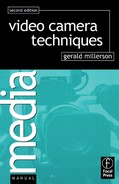If the angle of your camera lens is similar to the angle at which the viewers are watching their TV screens (e.g. 20° – 25°), then the perspective in their pictures will look accurate. Sizes and distances seem natural.
When you use a much wider lens angle (shorter focal length) or narrower lens angle (longer focal length), the apparent depth and scale on the screen will differ from those in the original scene.
The narrow-angle lens – As the lens angle narrows not only do things look closer, but the screen shows a smaller and smaller segment of the scene. As a result, pictorial perspective appears flattened. Depth seems compressed. The foreground-to-background distance is reduced, and subjects that are far away appear disproportionately large. Distant people and buildings may look like cut-outs. Anything moving to or from the camera seems to cover the distance very slowly. Camera dollying (tracking) looks remarkably slow, and produces only gradual visual changes.
The wide-angle lens – As you widen the lens angle, perspective becomes increasingly exaggerated. Space, depth and distance are emphasized, looking far greater than they really are. Even subjects that are not all that far away, seem unnaturally small. People appear to cover the ground in rapid strides as they approach. Dollying seems much faster than normal.
Theoretically these various distortions arise whenever the lens angle varies from ‘normal’, but they only start to become really noticeable below about 10° and above 30°. They are most obvious in scenes with strong perspective clues, such as architectural subjects, repeated patterns, railway tracks, etc. Perspective distortion is least apparent where there are few visual clues, as in shots of open spaces.
You can use perspective distortion to create deliberate spatial effects: The narrow-angle lens – You can reduce the impression of depth and space; create a compressed ‘crowded-in’ effect; group together distant and nearby subjects – e.g. pulling together a straggling parade that stretches away into the distance.
The wide-angle lens – Even cramped confined spaces can be made to look much bigger on the screen when shot with a wide-angle lens. A modestly sized setting can seem spacious. You can also use the wide-angle lens dramatically – e.g. to emphasize gestures in low-angle shots, or to distort subjects in close-ups.
Viewing distance
The distance from which you watch a TV picture should vary with the size of the screen. Too close and no extra subject detail is visible. Too far from it and you cannot see all available detail. To see maximum detail, a distance of 4–6 times picture height is often recommened. The screen is at an angle of about 20°–27° to the eye. When the camera lens horizontal angle is roughly similar, perspective in the picture appears natural.

Natural perspective
If you watch the screen from too far away, or a wide-angle lens is used to shoot the scene, depth and distance appear exaggerated in the picture. Viewed too closely, or shot with a narrow lens angle, depth and distance are compressed and distant subjects look unnaturally large.

